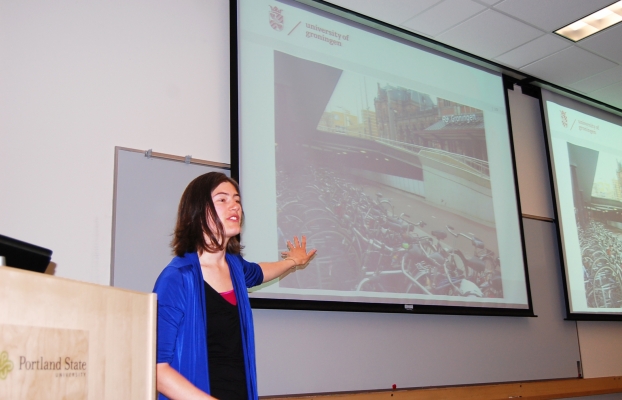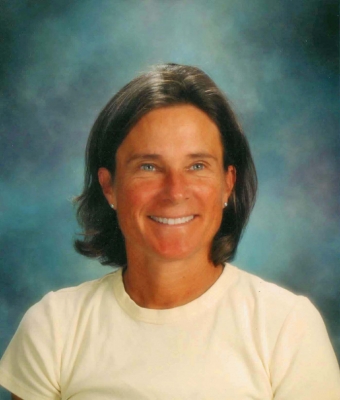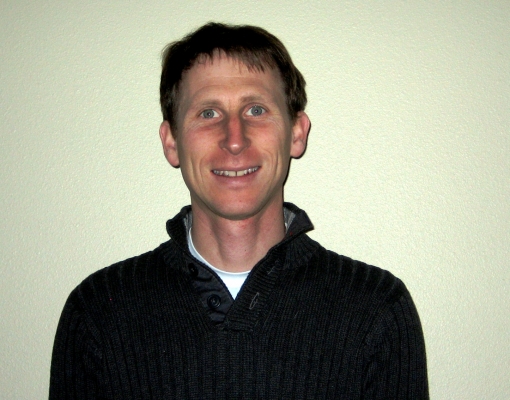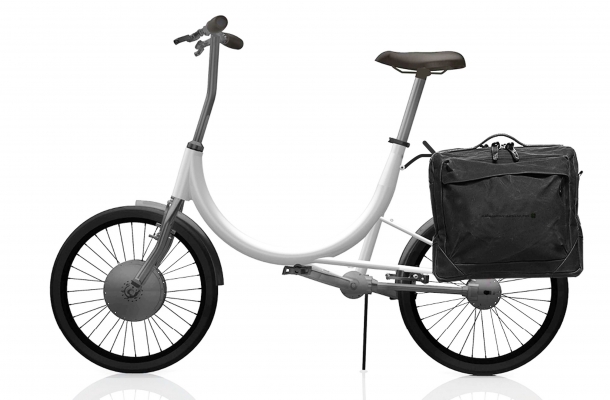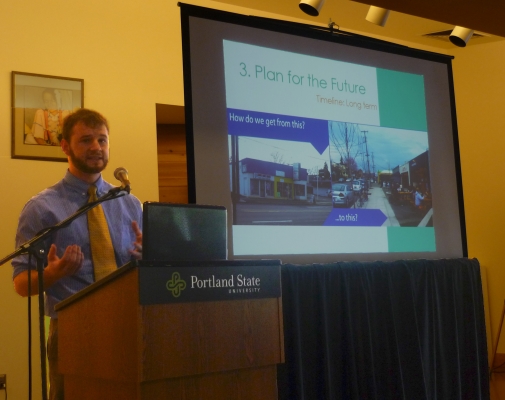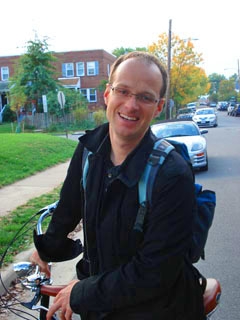OTREC at Portland State University welcomed Eva Heinen of the University of Groningen, The Netherlands, for a special seminar June 18. Around 40 people attended the presentation, held at the Intelligent Transportation Systems Laboratory and titled “Cycling in the Netherlands and Multi-Modality.”
Eva Heinen is assistant professor of infrastructure planning and mobility at the Department of Spatial Planning and Environment, Faculty of Spatial Sciences, University of Groningen. She earned a Ph.D. from Delft University of Technology in 2011 focusing on bicycle commuting.
Many people in Groningen and The Netherlands as a whole combine transit and bicycling for trips. A typical configuration involves cycling from home to a train station and then renting another bicycle to reach the final destination, Heinen said.
Few people take bicycles on transit, Heinen said, and buses don’t offer bike racks or other accommodations. Folding bikes, whose compact size allows for portability, are one exception, Heinen said. Electric-assist bikes are also popular, particularly with older people.
Heinen has published many papers on cycling in international and national journals and has a large international network in cycling. She spent three months at the University of California in Davis as a visiting scholar. She is a member of the editorial board of Rooilijn, a Dutch journal for science and policy in spatial planning; a member of the Bicycle Committee; co-chair of the...
Read moreCalvin Tribby, a Ph.D. candidate at the University of Utah, was recently awarded one of NITC's 2013 dissertation fellowships.
The 2013 NITC dissertation fellowships have been awarded, and Gail Meakins, of the University of Utah, has been selected for a $7,500 NITC fellowship to support her dissertation research.
Meakins's Ph.D. program of study combines her two fields of interest by studying the connection between the built environment and public health.
A former athletic director, Meakins made a major career change in 2008 to go back to school and study Urban Planning.
"My lifelong passion for, and interest in, physical activity and sport began at a very early age," she said. Always a competitive swimmer and runner, she became intrigued with city design over time.
After earning her Bachelor's and Master's of Arts in Physical Education from the University of California, Berkeley in the mid-1970's, Meakins worked for over 20 years in physical education and health at the middle school, high school, and collegiate level.
"Throughout the years I have had the opportunity to travel extensively, and developed a strong interest in both urban design and architecture," Meakins said. In the course of her travels, she couldn't help but notice wide differences between neighborhoods, in terms of the availability of active travel modes.
Her...
Read moreOTREC at Portland State University is pleased to announce the 2013 OTREC/NITC scholars.
Each year, OTREC and NITC recognize outstanding students, awarding them scholarships to further their work on transportation projects.
This year's scholarship winners tackle a range of projects, including long-range visions on how to improve equity in transportation, plans for proposed facility upgrades at specific locations, investigations into new ways to strengthen pavement, and the development of advanced technologies to assist the flow of transportation in the real world.
OTREC executive committee member Marc Schlossberg of University of Oregon will present a lecture June 19 for the U.S. Department of Transportation's Research and Innovative Technology Administration in Washington, D.C. Schlossberg will offer insights into the Sustainable Cities Initiative as part of the U.S. DOT's Transportation Innovation Series.
The Sustainable Cities Initiative at the University of Oregon promotes education, service, public outreach and research on the design and development of sustainable cities. The initiative's Sustainable City Year program puts the institutional resources of the University of Oregon to use solving the problems of a single Oregon city. Each year, the program connects around 30 courses across a dozen disciplines and involves more than 500 students. Students work to address projects identified by city staff.
Schlossberg's lecture will provide details on the educational model, explain how the model works and provide details on how it could change higher education to meet transportaiton needs.
Click here for details on the lecture.
More information on the Sustainable Cities Initiative is here.
Even as Portland racks up bike-friendly honors, ongoing research at Portland State University is shedding light on a new travel option that promises to get even more people on two wheels. Electric-assist bikes, or e-bikes, could hold the key to increasing cycling, particularly among women, older adults and people with physical limitations.
Portland State researchers Jennifer Dill and John MacArthur are exploring people’s perceptions and attitudes toward e-bikes and evaluating their use to see if these bikes encourage new cyclists. This spring, they’re loaning out locally made, GPS-equipped e-bikes to 120 people to learn about people’s actual experience using the bikes, marking the first time such research has been done in the country.
The research also includes a survey on e-bike use, which will help others understand the potential market. People who have ridden e-bikes can participate in this research by taking the survey at tinyurl.com/e-bike-survey.
E-bike use is increasing in North America, with many people switching from private cars and others using e-bikes to keep cycling as they age or after an injury. Increased use brings increased scrutiny, and efforts are already underway to limit where e-bikes can go and who can ride them. Many states require e-bike riders be licensed, set age limits or both.
Some local regulations prohibit e-bikes on bicycle and pedestrian paths. The city of Toronto,...
Read moreEach year, Portland State University’s MURP, or Master’s of Urban and Regional Planning, program hosts a public presentation to showcase the work of its graduating master’s students. Students who graduate with a Master’s in Urban and Regional Planning spend the last two terms of their program collaborating on workshop projects, completing planning tasks for local clients or business organizations.
This year’s presentations took place on Wednesday, attended by a crowd of about a hundred PSU students, professors, MURP clients and community members. Six groups presented their projects. Some of the projects were transportation-focused, especially one titled "Lombard Re-Imagined."
Swift Planning Group, composed of members Kathryn Doherty-Chapman, Zef Wagner, Brian Hurley, Jake Warr, Rebecca Hamilton, and Jodi Jacobson-Swartfager, developed a plan to improve Lombard Street, a key transportation corridor in North Portland.
The challenge facing the group had to do with the many roles that Lombard street plays. The street is both an arterial throughway and a state highway. It is an overdimensional freight route, for trucks that are too big to go anywhere else in North Portland, and it has also been designated as a main street in Metro’s 2040 Growth Concept. The various...
Read moreThousands of University of Oregon students use the 13th Avenue corridor in Eugene reach campus largely by bus, bike and foot, yet the return journey from campus to downtown cannot be made along the same route. The land uses adjacent to 13th Avenue are transforming to support an improving downtown and a growing campus, but the roadway is not adapting to these changes, but the roadway has not yet adapted to these changes, causing concerns about safety and undermining economic potential that should be of major interest to the City of Eugene and the University of Oregon given its policies to support sustainable transportation, urban revitalization.
University of Oregon students, as part of an interdisciplinary organization called LiveMove ByDesign, have spent the 2012-2013 academic year conducting a study for the 13th Avenue corridor. Through extensive observation of transportation behavior, parking utilization, and of case studies across the globe, the group developed a preferred roadway re-design that improves safety and access for all modes of transportation. LiveMove, the OTREC-funded student transportation group, is hosting an open house today to unveil its findings and innovative designs.
Attendees will have an opportunity to give feedback and input, and initiate community discussion on improving the corridor’s safety, accessibility and livability, while also stimulating economic activity and achieving city and university sustainability goals. “This is not...
Read moreThe National Institute for Transportation and Communities (NITC) invites proposals for research, education, and technology transfer transportation projects that support innovations in: livability, incorporating safety and environmental sustainability
Please read the RFP carefully as it contains three different grant opportunities:
... Read moreWhat makes Americans’ travel behaviors so different from that of their West European counterparts? Longer trip distances? Higher rates of licenses and auto-ownership? A culture and economy that depends on the automobile industry? According to visiting scholar Ralph Buehler, none of these explain the differences in mode splits.
In partnership with Students in Transportation Engineering and Planning (STEP), Portland State University recently hosted visiting scholar Ralph Buehler at the Friday Transportation Seminar series. Dr. Buehler traveled west from Washington, D.C. where he is an Assistant Professor in Urban Affairs and Planning at Virginia Tech’s Metropolitan Institute. Dr. Beuhler’s research and expertise is in multimodal planning and travel behaviors, with a focus on Western Europe and North America.
Click here to view the webcast.
Dr. Buehler’s presentation, titled “Making Urban Transport Sustainable: Comparison of Germany and the US,” poked holes in many of the common theories explaining why Americans are more likely to use their cars for all their travel needs. Instead, he noted that, “transport policies have to explain the difference [in mode shares] over time, including the changes that have happened in Germany and those that have not happened in the US. ” His research has led him to identify four major policy...
Read more
